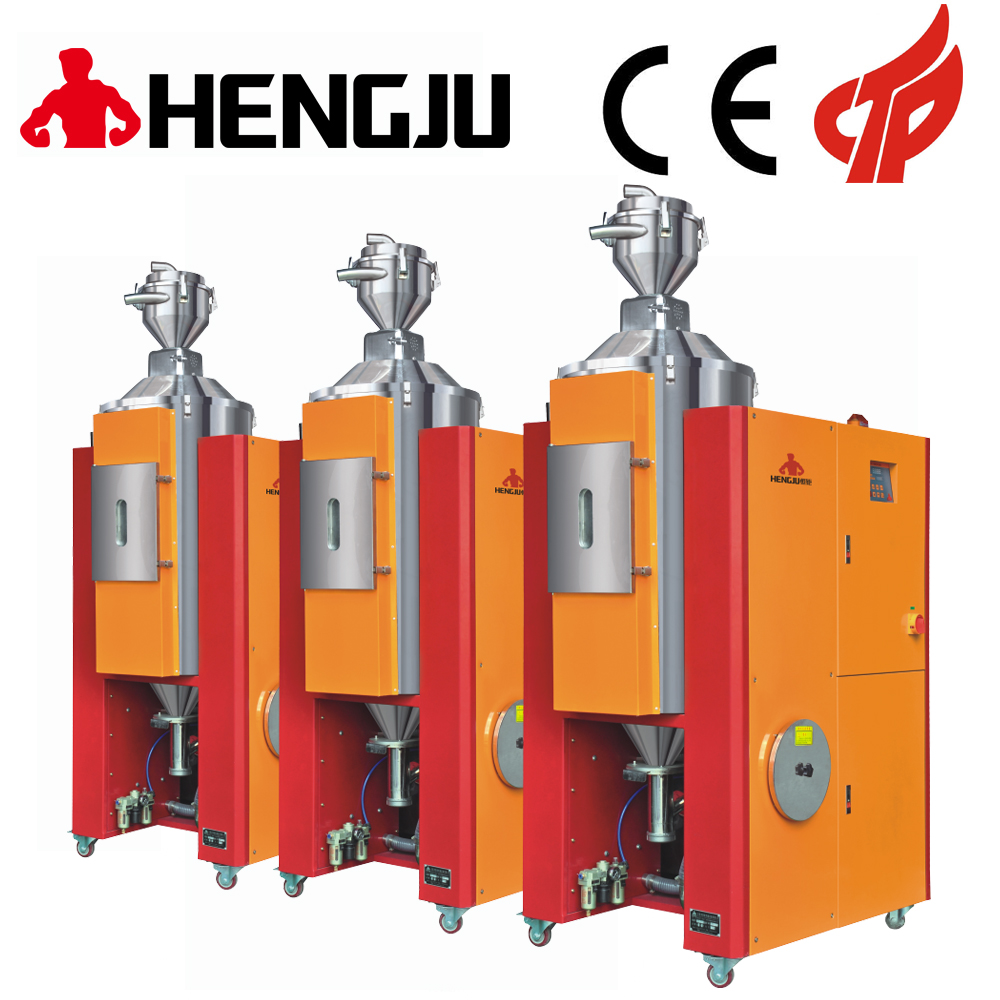In industrial production, some raw materials usually have strong hygroscopicity. In order to ensure high product molding quality, the raw materials need to be dehumidified and dried. In the past, companies used traditional hot air blowers. If they encounter wet weather, the hot air blowers can hardly complete the drying purpose. The desiccant dryer was created to improve the disadvantages of the hot air blower, which can quickly and effectively dry the raw materials. So what is the difference between a dehumidification dryer and a traditional hot air blower?

1. Dehumidification dryer:
The air pipeline of the dehumidification dryer adopts a closed circulation system, which can not be affected by the external weather. It can dry the material well in dry weather or wet weather without reversing moisture. It effectively improves the shortcomings of traditional hot air blowers. It first draws in ambient air to remove moisture in the air under low dew point, and then heats the dried air to the dryer to dehumidify and dry the material. Improve work efficiency and reduce drying time, and the drying effect is excellent. In addition, the filter installed in the desiccant dryer can prevent dust leakage from causing pollution in the factory and keep the air environment clean.
2. Traditional hot air dryer:
In order to evaporate the moisture in the material, the traditional hot air blower uses the hot air heated by electric heating to dry the material at high temperature. However, due to weather factors, dry weather and humid weather, the moisture content in the air will be different, and the drying effect will also be different. In traditional hot air blowers, electric heating must first heat the incoming air. If the weather is too humid and the incoming air contains high moisture, it will be difficult for the material to dry.
Four elements of drying: temperature, air volume, time, dew point value. Compared with ordinary hot air dryers, Ruida mechanical dehumidification dryers first remove most of the water in the air, and then use the water with very little water content. The air circulates hot air to dry the material (the dry air may reach a dew point of tens of degrees below zero), so that the dry air can more effectively remove water from the material under heating, which is particularly effective for materials that are difficult to dry. It can dry hygroscopic materials more thoroughly. As for the ordinary hot air dryer, it can only rely on heating to volatilize and blow away the moisture on the surface, and the moisture content of the final material can only be balanced with the moisture content of the air inhaled outside. For materials that require very low water content to be molded, ordinary hot air dryers cannot meet the requirements.
With the widespread use of engineering plastics, dehumidifying dryers have gradually replaced traditional hot air dryers (ovens). The use of dehumidification dryer has the following four major benefits:
1. The water in the plastic raw materials can be taken away to eliminate the generation of bubbles, so that the product can achieve the ideal mechanical, electrical, dimensional stability and smooth and beautiful appearance.
2. Prevent the production of defective products and the loss of returned goods, and greatly reduce the production of waste.
3. Because the desiccant dryer uses very dry air for dehumidification, it can shorten the drying time and save working hours.
4. The air pipeline of the dehumidifier dryer adopts a sealed circulation system and is equipped with a filter, so it is not affected by the external climate, and can prevent dust from causing pollution in the factory and improve the working environment.
How to achieve the highest drying efficiency?
The determinants of a good drying efficiency have the following four points: drying temperature (Drying Temperature), drying time (Residence time), air flow (Air flow), dew point (Dew point). These four factors are interlinked, and any change in one condition will affect the drying effect.
Drying Temperature refers to the temperature of the air entering the drying barrel. Due to its physical properties, such as molecular structure, specific gravity, specific heat, moisture content, etc., each raw material has a certain temperature limit during drying. When the temperature is too high Part of the additives in the raw materials will be volatilized and deteriorated or agglomerated. Too low will make some crystalline raw materials unable to reach the required drying conditions, such as: PC/120℃, ABS/80~95℃. In addition, insulation and heat preservation are required in the selection of dry barrels to avoid loss of drying temperature, resulting in insufficient drying temperature or waste of energy.
Drying time (Residence time) refers to the pre-drying time of raw materials before molding. Too long drying time will cause raw materials to deteriorate or agglomerate or waste energy. Too short drying time will cause excessive moisture content. For example: PC/3-4 hours, ABS/3-4 hours.
Air flow is the only medium that takes away the moisture in the raw materials. The air flow will affect the dehumidification effect. Too much air volume will cause the return air temperature to be too high, resulting in over heat and affecting the stability of the dew point. Too small air volume will not completely take away the moisture in the raw materials. The air volume also represents the dehumidification capacity of the dehumidifier dryer.
Dew point temperature (Dew point) refers to the temperature at which the moisture contained in the gas is condensed into water droplets when the gas is cooled, and is a measure of the degree of dryness (wetness) of the gas. The less moisture in the gas, the lower the dew point temperature. The dew point of a good desiccant dryer should reach a dew point temperature of -40°C.
The use of dehumidification dryers can be divided into stand-alone and centralized. Stand-alone dehumidification dryers usually include a dryer host, a drying barrel, and a suction machine. The use of a single machine is suitable for a small amount of various drying, and its advantages are good drying efficiency and convenient and fast material change. The centralized dryer includes a dryer host and several drying barrels. Each drying barrel has an independent heating controller, which can dry several different raw materials at the same time, and cooperates with an air volume regulating valve to control the air volume of each drying barrel.
|
 +8613669807274
+8613669807274
 +8613669807274
+8613669807274 wto-btb@wto-btb.com
wto-btb@wto-btb.com Tel: +8613669807274
Tel: +8613669807274 SMS: +8613669807274
SMS: +8613669807274